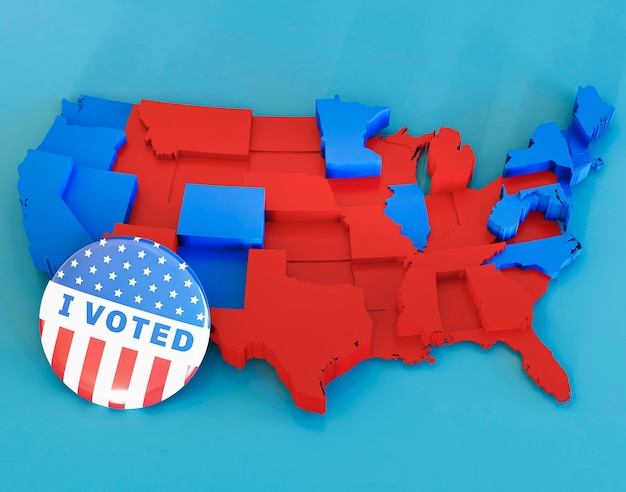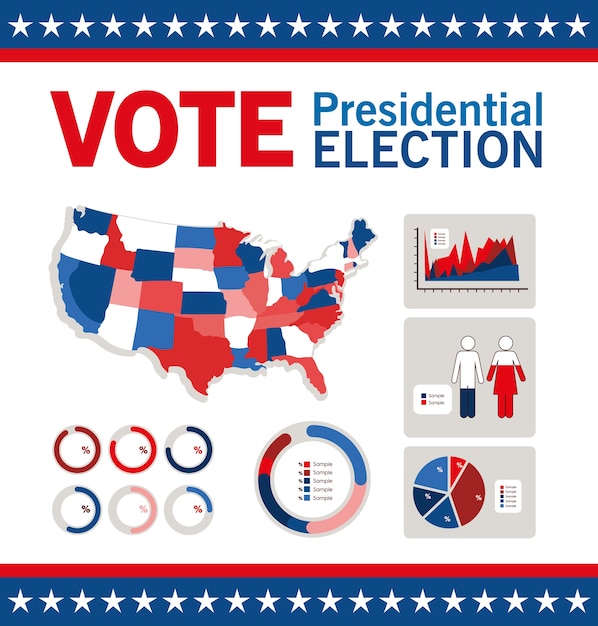Understanding the Electoral College: 2025 and Beyond

Understanding the Electoral College: Can a Candidate Win the Presidency Without the Popular Vote in 2025? Yes, it is possible for a candidate to win the U.S. presidency without winning the popular vote due to the Electoral College system, where electoral votes are allocated to each state based on population.
The Understanding the Electoral College: Can a Candidate Win the Presidency Without the Popular Vote in 2025? remains a crucial question in American politics, especially as we look towards future elections. This system, enshrined in the U.S. Constitution, has led to instances where the candidate with fewer individual votes assumes the highest office, sparking debate and calls for reform.
The Electoral College: A Foundation of American Democracy
The Electoral College is a body of electors established by the United States Constitution, constituted every four years for the sole purpose of electing the president and vice president of the U.S. The number of electors in each state is equal to the total number of senators (always two) and representatives that state has in Congress. This system was a compromise between a popular vote election and a congressional election of the president.
Understanding the Electoral College requires examining its historical context, its benefits according to its proponents, and the criticisms it faces. The ongoing debate centers on whether it truly represents the will of the people and whether it should be reformed or abolished.
Historical Context of the Electoral College
The Founding Fathers created the Electoral College for several reasons. They were wary of pure democracy, fearing that an uninformed populace could easily be swayed. They also wanted to balance the power between densely populated states and those with smaller populations. This ensured that smaller states still had a voice in presidential elections.
Arguments in Favor of the Electoral College
Proponents argue that the Electoral College protects rural states, prevents a “tyranny of the majority,” and requires candidates to build broad coalitions across different regions. It also simplifies the election process by focusing on state-level contests rather than a nationwide popular vote.
- Protects smaller states’ influence in presidential elections.
- Encourages candidates to campaign and address issues in diverse regions.
- Provides a clear winner, avoiding potential recounts or disputes in a close popular vote.

In conclusion, the Electoral College was designed as a compromise to balance various interests during the formation of the United States. Its supporters believe it continues to serve important functions in the American political system.
How the Electoral College Works in Practice
The Electoral College process involves several steps, from the selection of electors to the final counting of electoral votes. Each state has its own method of choosing electors, but generally, they are nominated by political parties. When citizens vote in the presidential election, they are technically voting for these electors, who have pledged to support a particular candidate.
Understanding the mechanics of the Electoral College is essential for grasping how a candidate can win the presidency without winning the most individual votes. The “winner-take-all” system in most states plays a significant role in this outcome.
The “Winner-Take-All” System
In most states, the candidate who wins the popular vote in that state receives all of its electoral votes. This “winner-take-all” system means that a candidate can win a state by a narrow margin and still gain all of its electoral votes. This system amplifies the importance of swing states, where the election is closely contested.
There are, however, a couple of exceptions to the winner-take-all rule. Maine and Nebraska use a proportional system, where electoral votes are divided based on the popular vote within the state.
The Role of Swing States
Swing states, or battleground states, are those where the election is expected to be close and where neither candidate has a strong advantage. These states often receive the most attention and resources from campaigns because they can be decisive in determining the outcome of the election.
- Candidates focus significant resources on campaigning in swing states.
- Outcomes in these states can disproportionately affect national election results.
- Shifting demographics in swing states can alter their political leanings over time.
In summary, the “winner-take-all” system and the strategic importance of swing states are key factors in understanding how the Electoral College can lead to a president being elected without winning the popular vote.
Instances of Presidents Winning Without the Popular Vote
Throughout U.S. history, there have been several instances where a presidential candidate won the Electoral College but lost the popular vote. These elections have often been controversial and have sparked intense debate about the fairness and legitimacy of the Electoral College.
Examining these historical examples can provide valuable insights into the potential for a similar outcome in the 2025 election and beyond. Each instance has its own unique circumstances and context.
The 1876 Election: Hayes vs. Tilden
The 1876 election between Rutherford B. Hayes and Samuel Tilden was one of the most contested and controversial elections in U.S. history. Tilden won the popular vote, but the Electoral College outcome was disputed, leading to a political crisis. Ultimately, Hayes was awarded the presidency through a special congressional commission.
The 2000 Election: Bush vs. Gore
The 2000 election between George W. Bush and Al Gore was another highly contested election where the popular vote winner did not become president. Gore won the popular vote, but the election hinged on the outcome in Florida, where the results were disputed. The Supreme Court ultimately halted a recount, giving Bush the Electoral College victory.
- The election highlighted the importance of every vote, particularly in swing states.
- Legal challenges and recounts can significantly impact the outcome of a close election.
- The Supreme Court’s involvement sparked debate about the judiciary’s role in elections.
The 2016 Election: Trump vs. Clinton
In 2016, Donald Trump won the presidency despite Hillary Clinton winning the popular vote by nearly three million votes. Trump’s victory was secured by winning key swing states such as Pennsylvania, Michigan, and Wisconsin by narrow margins.

In conclusion, history shows that it is indeed possible for a candidate to win the presidency without winning the popular vote, underscoring the complexities and potential controversies associated with the Electoral College.
Potential Scenarios for 2025
Looking ahead to the 2025 presidential election, there are several factors that could contribute to a scenario where the Electoral College winner differs from the popular vote winner. These include demographic shifts, regional polarization, and the influence of third-party candidates.
Understanding these potential scenarios can help voters and political analysts anticipate and interpret the election results. The evolving political landscape adds complexity to the Electoral College dynamics.
Demographic Shifts and Their Impact
Changes in the demographic makeup of states can significantly alter their political leanings. States with growing minority populations, for example, may become more Democratic, while states with aging populations may lean more Republican. These shifts can affect the outcome of both the popular vote and the Electoral College.
Regional Polarization and the Electoral Map
Increasing regional polarization, where different parts of the country become more politically distinct, can exacerbate the potential for a split between the popular vote and the Electoral College. If one party dominates certain regions, it can be difficult for the other party to win enough electoral votes, even with a strong showing in the popular vote.
- Regional political identities are becoming more pronounced.
- Candidates need to balance appealing to their base with attracting moderate voters.
- The Electoral College magnifies the impact of regional political divides.
The Role of Third-Party Candidates
Third-party candidates can also play a significant role in presidential elections, particularly if they draw support from one of the major party candidates. Even a small percentage of votes for a third-party candidate can be enough to swing the outcome in a close state, affecting the Electoral College result.
In summary, demographic shifts, regional polarization, and the presence of third-party candidates are all factors that could contribute to a scenario where the Electoral College winner differs from the popular vote winner in 2025.
Arguments for and Against the Electoral College
The Electoral College has been a subject of debate since its inception, with strong arguments both for and against its continued use. Proponents argue that it protects smaller states and prevents a “tyranny of the majority,” while opponents argue that it undermines the principle of one person, one vote.
The future of the Electoral College may depend on whether these competing arguments can be reconciled. The ongoing debate reflects fundamental questions about the nature of democracy and representation.
Arguments in Favor of Maintaining the Electoral College
Those who support the Electoral College believe that it serves several important functions. They argue that it protects the interests of rural states, prevents candidates from focusing solely on densely populated areas, and promotes national unity by requiring candidates to build broad coalitions.
Arguments for Reforming or Abolishing the Electoral College
Critics of the Electoral College argue that it is undemocratic and that it disenfranchises voters by allowing a candidate to win the presidency without winning the popular vote. They believe that it gives disproportionate power to swing states and that it can lead to political instability.
- Reform advocates propose a national popular vote interstate compact.
- Abolitionists call for a constitutional amendment to eliminate the Electoral College.
- Critics argue the current system does not fairly represent the will of the people.
Potential Reforms and Their Implications
There have been various proposals for reforming the Electoral College, ranging from the National Popular Vote Interstate Compact to a constitutional amendment abolishing the system altogether. Each of these reforms would have significant implications for the American political landscape.
In conclusion, the debate over the Electoral College reflects fundamental disagreements about the nature of democracy and representation. The future of the system may depend on whether a consensus can be reached on its merits and drawbacks.
The Electoral College and the Future of American Democracy
The Electoral College remains a central feature of the American political system, with significant implications for future elections. Understanding its workings, its historical context, and the arguments surrounding it is essential for informed civic engagement.
As the United States continues to evolve, the debate over the Electoral College is likely to persist. Its role in shaping the outcomes of presidential elections ensures that it will remain a topic of public discussion and political debate.
| Key Point | Brief Description |
|---|---|
| 🏛️ Electoral College | System for electing the U.S. President, not a direct popular vote. |
| 🔑 Winner-Take-All | Most states give all electoral votes to the popular vote winner in that state. |
| 📊 Swing States | States where the election outcome is uncertain, heavily contested. |
| 🗳️ Popular Vote vs. Presidency | A candidate can win the presidency without winning the popular vote due to the Electoral College. |
Frequently Asked Questions About the Electoral College
The Electoral College was created as a compromise between electing the president by popular vote and electing the president by a vote in Congress. It aimed to balance the influence of populous states and less populous ones.
Each state is allocated a number of electors equal to its total number of representatives in Congress (House + Senate). Every state has at least three electors, as each state has two senators and at least one representative.
If no candidate receives a majority of electoral votes (270 or more), the House of Representatives elects the president from the top three candidates. Each state delegation gets one vote in this process.
In many states, there are laws requiring electors to vote for the candidate they pledged to support, and some states have penalties for “faithless electors” who vote differently. However, the legal enforceability of these laws is not fully settled.
Yes, the Electoral College could be abolished or reformed through a constitutional amendment, which requires a two-thirds vote in both the House and Senate and ratification by three-quarters of the states. Alternatively, the National Popular Vote Interstate Compact seeks to achieve a similar result without a constitutional amendment.
Conclusion
In conclusion, the Understanding the Electoral College: Can a Candidate Win the Presidency Without the Popular Vote in 2025? continues to be a relevant question. The complexities of the system ensure ongoing discussion and debate about its fairness and effectiveness in representing the will of the American people.
